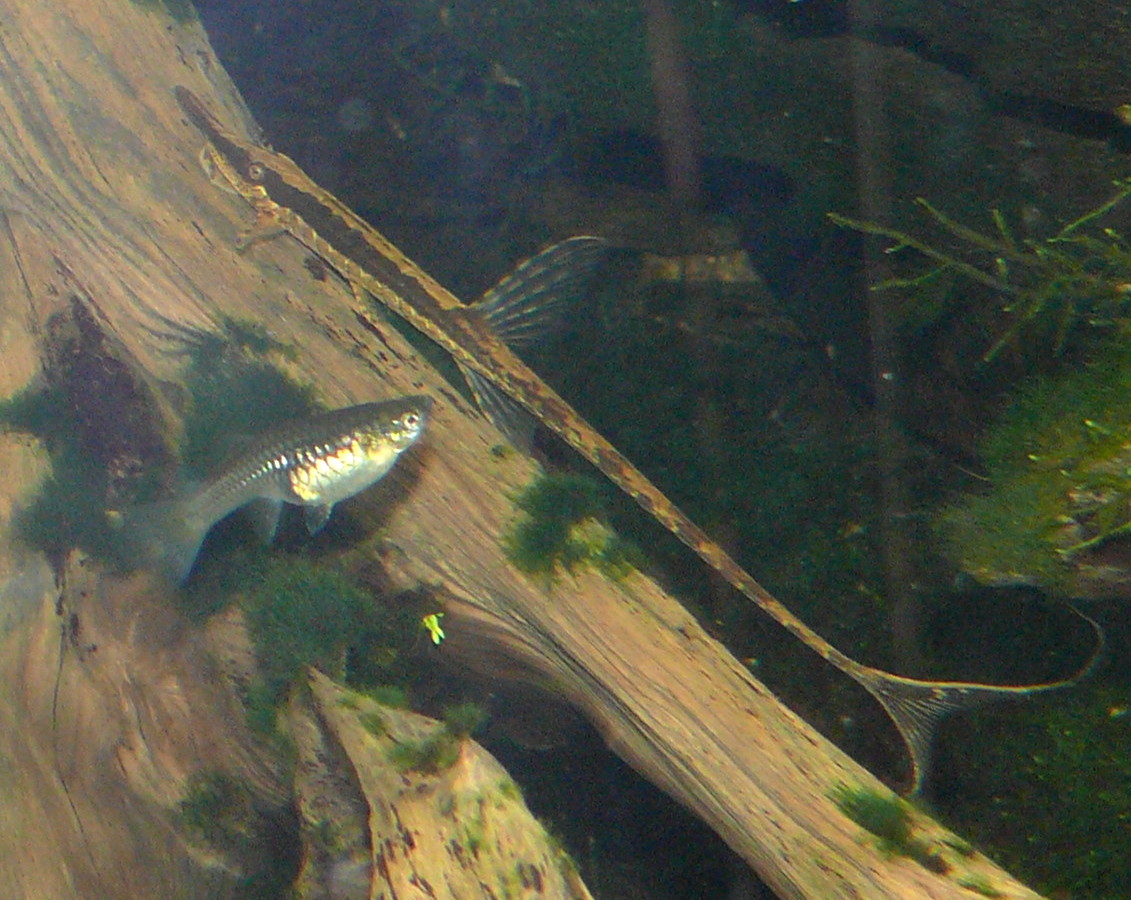- Farlowella
Taxobox
name = "Farlowella"

image_width = 240px
image_caption = "Farlowella arcus"
regnum =Animal ia
phylum = Chordata
classis =Actinopterygii
ordo = Siluriformes
familia =Loricariidae
subfamilia =Loricariinae
tribus =Harttiini
genus = "Farlowella"
genus_authority = Eigenmann and Eigenmann, 1889
type_species = "Acestra acus"
type_species_authority = Kner, 1853
subdivision_ranks = Species
subdivision ="See text."
synonyms = "Acestra" Kner, 1853"Farlowella" is a
genus ofcatfish (order Siluriformes) of the familyLoricariidae . Thesefish resembletwig s orstick s, hence thecommon name s twig catfish or stick catfish. They may also sometimes be referred to as whiptail catfish. Twig catfishes are natives ofSouth America .Taxonomy
"Farlowella" is placed within the tribe
Harttiini of the subfamilyLoricariinae . Morphological, molecular, and phylogenetic studies have placed "Farlowella" as sister to "Sturisoma ".The genus name of "Farlowella" is named in honor of
William Gilson Farlow , a famous Americanbotanist ofHarvard University whose main work was working withalgae plants, the favorite food of this slendercatfish .FishBase genus|genus=Farlowella|year=2007|month=May]Distribution
The genus "Farlowella" is broadly distributed in Amazon, Orinoco, Paraná, and coastal rivers of the
Guyana Shield . It is absent from thePacific slope of theAndes and from the coastal rivers of theBrazil ian shield.cite journal|url=http://www.mapress.com/zootaxa/2007f/zt01462p040.pdf|title=The genera of the Neotropical armored catfish subfamily Loricariinae (Siluriformes: Loricariidae): a practical key and synopsis|first=Raphael|last=Covain|coauthors=Fisch-Muller, Sonia|journal=Zootaxa |volume=1462|pages=1–40|year=2007|format=PDF ]Appearance and anatomy
"Farlowella" has a unique body shape that resembles of a thin stick of wood. The body is slender and elongate, often with a pronounced
rostrum and a brownish color with two lateral dark stripes beginning at the tip of the rostrum, passing over the eyes and ending at the tail, which are periodically interrupted on the caudal peduncle. Sexual dimorphism includes hypertrophiedodontode s along the sides of the rostrum or the head in species with a short rostrum.There are only slight differences between the different types which sometimes lead to confusion. A very important identification is the presence of ventral
scutes on these species which differentiates them from each other. Twig catfishes grow between 10centimetre s (4 in) SL in "F. smithi" and 26.5 cm (10.4 in) SL in "F. nattereri".FishBase species|genus=Farlowella|species=smithi|year=2007|month=May] FishBase species|genus=Farlowella|species=nattereri|year=2007|month=May]Habitat and ecology
Twig catfishes feed primarily on algae in their natural habitat. Species inhabit areas of gently flowing water in submerged dead leaves and sticks, among which it blends in as a form of
camouflage . Some specimens can sometimes be found in swift current over rocks and submerged wood. These speciesappear scarce, but this may partially be explained by their mimicry. These species are open water brooders. The eggsare laid on open vertical surfaces such as submerged vegetation or rocks, in a single layer and are guarded by the male.In the aquarium
"F. acus", "F. vittata" and "F. gracillis" are the most commonly exported species for the
aquarium .cite web|url=http://www.scotcat.com/factsheets/farlowella_acus.htm|title="Farlowella acus"|publisher=Scotcat.com|accessdate=2007-05-20] Twig catfishes require clean water with highdissolved oxygen content.cite web|url=http://www.wetwebmedia.com/FWSubWebIndex/loricariids.htm|title=The South (and Central) American Suckermouth Catfishes, Family Loricariidae|last=Fenner|first=Robert|accessdate=2007-05-20] Twig catfish are often lost without enough greens to feed upon.pecies list
Species according to
ITIS .ITIS|ID=164357|taxon="Farlowella"|year=2007|date=May 20]*"
Farlowella acus " (Kner, 1853)
*"Farlowella altocorpus " Retzer, 2006 [cite journal|url=http://www.mapress.com/zootaxa/2006f/zt01282p068.pdf|title=A new species of Farlowella Eigenmann and Eigenmann (Siluriformes: Loricariidae), a stickcatfish from Bolivia|first=Michael E.|last=Retzer|journal=Zootaxa |volume=1282|pages=59–68|year=2006|format=PDF ]
*"Farlowella amazonum " (Günther, 1864)
*"Farlowella colombiensis " Retzer & Page, 1997
*"Farlowella curtirostra " Myers, 1942
*"Farlowella gracilis " Regan, 1904
*"Farlowella hahni " Meinken, 1937
*"Farlowella hasemani " Eigenmann & Vance, 1917
*"Farlowella henriquei " Miranda-Ribeiro, 1918
*"Farlowella isbruckeri " Retzer & Page, 1997
*"Farlowella jauruensis " Eigenmann & Vance, 1917
*"Farlowella knerii " (Steindachner, 1882)
*"Farlowella mariaelenae " Martín Salazar, 1964
*"Farlowella martini " Fernández-Yépez, 1972
*"Farlowella nattereri " Steindachner, 1910
*"Farlowella odontotumulus " Retzer & Page, 1997
*"Farlowella oxyrryncha " (Kner, 1853)
*"Farlowella paraguayensis " Retzer & Page, 1997
*"Farlowella platoryncha " Retzer & Page, 1997
*"Farlowella reticulata " Boeseman, 1971
*"Farlowella rugosa " Boeseman, 1971
*"Farlowella schreitmuelleri " Ahl, 1937
*"Farlowella smithi " Fowler, 1913
*"Farlowella taphorni " Retzer & Page, 1997
*"Farlowella venezuelensis " Martín Salazar, 1964
*"Farlowella vittata " Myers, 1942ee also
*
List of freshwater aquarium fish species References
Wikimedia Foundation. 2010.
